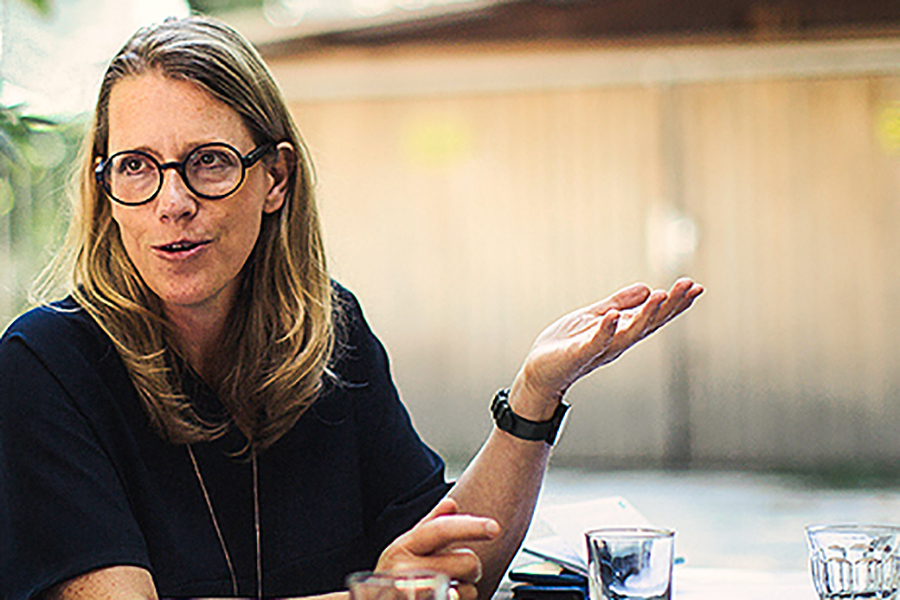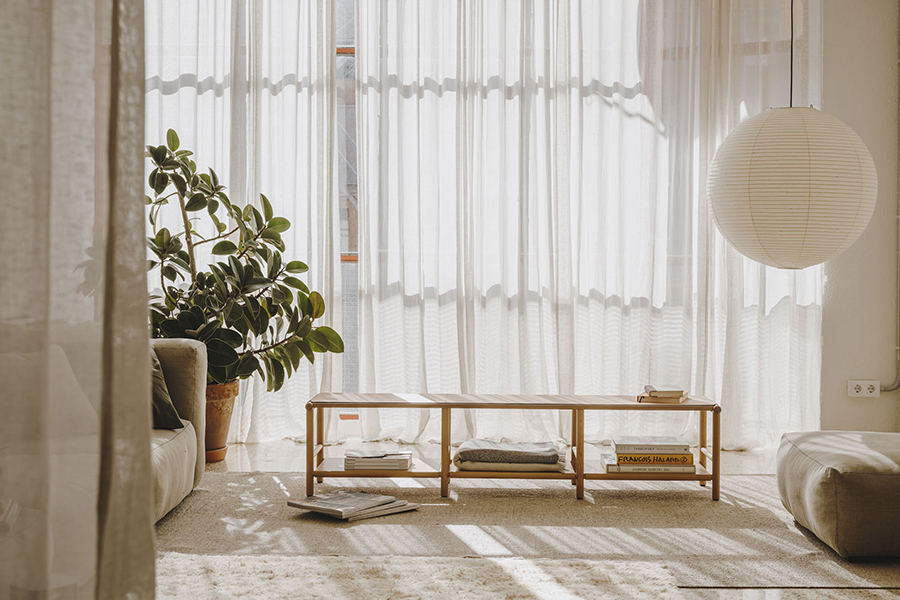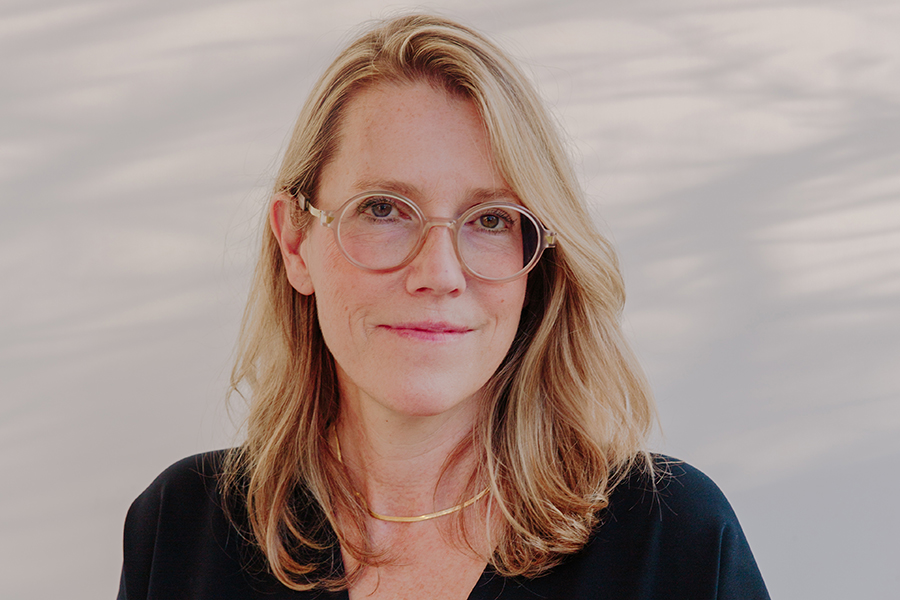Jeannette Altherr: “is there anything more important than life itself?”

We live in a time when many people are intensely concerned about the exploitation of nature and the impacts of climate change. Can designers influence such developments? Or does our perception of these social circumstances influence creatives’ ideas? What role do designers play in shaping our future?
In our interview with Jeannette Altherr (Studio Altherr Désile Park), the designer depicts the complexity of the sustainability issue as a challenge for designers, companies and consumers alike and shows that the key to finding solutions lies in holistic thinking. A snapshot of the sustainability debate in the interiors sector.
burgbad magazin: For a long time, the connection between interiors and nature was nothing more than a discussion about low-toxin furniture driven by the eco movement – and therefore more a question of a healthy indoor climate rather than a healthy global climate. That’s changed in a big way. Today, “green living” is measured in terms of aspects like the climate neutrality and sustainability of the design – a very complex situation. Could that be where the longing for a new kind of simplicity comes from?
Jeannette Altherr: We’ve always identified with “essentialism”. The difference between that approach and simplicity is that we’re not so much interested in aspects that only relate to form as in the search for what’s important, what really matters. And is there anything more important than life itself? Our sense of beauty and our idea of a good life are closely linked. We might not always know what’s beautiful, but we have a very precise idea of what isn’t beautiful: impoverishment, contamination, dullness. Right now we’re experiencing how our idea of nature as “the other” is changing – from seeing it as nothing but a resource provider to the idea of nature as a living system in its own right. We’re coming to see ourselves as part of this living system, not as something that stands above it. Balance is an essential aspect of that. This development will definitely change our perception of what’s beautiful. As designers, we try to find a form for something that’s already in the air – a wish, a mood, a vague, collective desire – but hasn’t found expression yet. We identify those tendencies and bring them to companies’ attention.
The discussion on social medial clearly shows that people hope designers will provide orientation in terms of how sustainable a product concept is too. That’s probably often a sign of confusion, which is only made worse by greenwashing. Aren’t designers soon out of their depth when faced with expectations like that?
Jeannette Altherr: First and foremost, it’s me who puts the pressure on myself. As long as product design turns into consumer goods, being a designer will always mean being closely linked with the fundamental problem of overconsumption. It’s a similar story with architects. That’s why a lot of designers are asking themselves whether they can actually carry on designing with a clear conscience at all, and if so what and how. For me at least, those questions led to a genuine crisis. And then there’s the enormous complexity of our moment in time. We have to comprehend that something can be “both … and”, that contradictions exist alongside one another as well as within ourselves, and that there are many questions to which there are no clear, simple answers: we’re all part of a big collective learning process.
You have to free yourself from the idea that you’ve got all the different factors under control. To start with – and forever after – you have to learn a great deal, because there are an incredible number of factors to take into account: from the origins of the materials to the production conditions, energy input, quality/longevity, long usage as a result of versatility, service requirements, transport costs and packaging, and last but not least recyclability. And on top of everything else, there are social aspects to be considered as well. I think the idea of what design can be will expand beyond the production of products. In “Broken Nature”, for instance, I was particularly moved by the examples of conserving, cherishing and documenting, as well as by the examples that visualised the dramatic nature of the world situation. Because scientific findings alone aren’t enough to change the way people think. We have to progress from knowing to understanding. Designers are becoming a filter in the sense that they observe all the different trends and tendencies and pick out and try anything that seems viable.

In the interiors sector, the discussion about sustainability models is a little calmer than, say, in the food industry. It takes longer to gather experience, learning processes are associated with higher investments. At the same time, the furniture industry has to be prepared for the fact that raw materials that are promoted with sustainability arguments – like wood, for example – could eventually become scarce too.
Jeannette Altherr: Yes, especially in view of this year’s devastating fires in the Amazon region and even more so in Australia, you start wondering whether you can carry on seeing trees as a renewable resource. In the face of so much oversupply, is “new” still such a positively charged word as it used to be? Or is good-quality slow design that can be repaired, modified or used second-hand actually the better option? The industry needs to give serious consideration to scenarios like that in good time. We have to think everything through with an open mind.
Well, there are no 100%-sustainable solutions, just as there’s no such thing as the perfect product, so consumers have to learn to weigh up the pros and cons. That’s a learning process we have to put them through. But nobody wants to be the first to stick their neck out.
Jeannette Altherr: The debate is so emotionally charged, and we’re in such a state of shock, that we feel a pressing need to do something and do it fast. And that often leads to simplified answers. Is it really better to replace plastic bags with cloth ones, for instance? And then end up with countless cloth bags that you never use again? Does it make sense to replace plastic straws with metal or glass straws? If a non-plastic cup has to be reused up to 3,000 times before the amount of resources that go into making it is lower than what goes into making a plastic cup – does that mean we should just keep relying on plastic? The fact is, we have to take a much more fundamental approach and think in life cycles. It’s not enough to stick with the throwaway system and simply replace the materials with different ones.
And at the same time, we have to learn to differentiate – quickly. At the end of the day, nobody questions the fact that we need to get the plastic waste out of our oceans. But the reflex reaction of demonising plastic falls short. On the one hand, plastic made from fossil resources is a very valuable and scarce material; in some areas – like certain medical applications – it’s irreplaceable, at least for the time being. On the other hand it’s a resource that’s being wasted, for instance by the mountain of packaging caused by a throwaway society with an ever-growing appetite for convenience products.
Jeannette Altherr: And just as it’s a mistake to see plastic as the root of all evil on the planet, thinking that bioplastics will solve the plastic problem is misguided too, because it comes with its own challenges. The real question is: which material really makes sense in what context? Durable plastic for furniture or devices isn’t the same thing as throwaway plastic. We so want to do the right thing – but what is the right thing? Abstinence? Or consuming “better”? And that soon raises the question as to who bears responsibility – the consumer or the manufacturer?

For companies, the challenge of sustainable business practices lies in embracing the complexity of sustainability and making it transparent. But they have to portray that complexity in a simplified way so as to be able to communicate their own answers and solutions effectively.
Jeannette Altherr: I think “process” is the key word here. A process takes time and experience. Take Arper, for instance: the company has had a sustainability department since 2005, and right from the start it’s strived for an approach based on life cycle assessment – it’s very sophisticated and the only one I know that seems genuinely consistent. Sometimes, certificates are a bureaucratic barrier to imports. But certification like the EPD label (Environmental Product Declaration) are a meaningful way to make products transparent, quantifiable and therefore comparable. That’s really the only way to enable people to make a conscious choice. Nor should the question of design and sustainability be limited to the issue of carbon reduction. I think it makes much more sense to replace the old, linear way of thinking with holistic thinking that permits complexity, uncertainty and contradictions instead of just trying to create the illusion that there’s one single, easy answer. The design approach and answers can range from ecology, conservation, restorative design, biodesign, saving energy, re-use, recycling or life cycle models all the way to raising awareness of beauty and protecting the things we love.
It’s fascinating to see how the sustainability debate is having an impact in all areas of life – not just with regard to consumption, but in terms of social standards and lifestyle as well. The climate crisis is a challenge for all areas of our societies. If you change any one aspect, the entire dynamic changes – whether you’re talking about the Gulf Stream or global financial transactions. But doesn’t that present an opportunity as well?
Jeannette Altherr: Yes, a society can learn too. And companies are also evolving and reacting to the latest findings and insights. They share the same experiences as we do and are changing as a result. A company like Arper, where this process has already been underway for 15 years, might find that encouraging and communicate its activities more intensely – despite the risk of being accused of greenwashing. And just because you can’t please everybody all the time in our media-driven world, we shouldn’t let that stop us from taking the steps needed to keep the empirical process going.
Here you can find the portrait of Jeannette Altherr.





